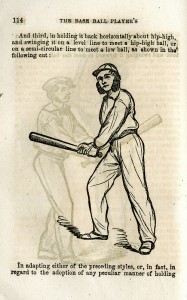
It’s baseball season in Baltimore! Huzzah! Huzzah? Yeah, the past decade or so was less than magical when it comes to the Orioles ability to, you know, win, but even the most dejected of O’s fans can rekindle their love for America’s pastime by looking at the old-timey goodness that is early baseball guidebooks at the George Peabody Library. Let’s face it, these guidebooks have everything, from illustrations of creep-tastic pitchers displaying the most jaunty of muttonchop styles to instructions on how to play baseball . . . on ICE!
Of course, these books offer more than mere exemplars of faddish facial hair; they are also great sources of social history. Think salary disputes are a relatively new thing? Well, it turns out that Reach’s Guide of 1889 discusses what was then called “the high salary evil,” in which upstanding managers were worried about the obscene amounts of money certain players were earning. What about concern over the average American’s girth? It is so not a twenty first century trend. According to Haney’s Base Ball Reference (1867), baseball will cure it:
The physique of Americans has long been a vulnerable point for the attacks of foreigners on the weaknesses our countrymen, and hitherto we have only too-well merited the palpable hits made by our healthy out-door-sport-loving cousins of England. Of late years, however, an improvement has been manifested in this respect, in America, and a reformation has been introduced, which bids fair to remove the cause of complaint, and to bring us up to the physical standard of our forefathers, whose well-exercised muscles enabled them to lay low the forests of the Western wilderness, and whose powers of endurance led them to withstand so manfully the fatigues and trials of the great seven years’ struggle for independence. (v)
Not only will playing baseball make you have the shredded abs that our forefathers like Ben Franklin and George Washington must surely have had, but will also help you stick it to the snobby British, what with all their fancy tea drinking and dressage and everything. USA!
The guidebooks are also chock-full of quaint ads for supplies and uniforms and various libations, as well as blurbs about all sorts of wild promotional stunts, like how in 1909 pitcher Charles E. Street caught a ball dropped from the Washington Monument. But there are also scandalous pieces of gossip and intrigue within the volumes, suggesting that the baseball diamond was like some sort of athletic and bewhiskered Peyton Place. For instance, Reach’s Guide of 1895 recounts the lurid tale of Charley Sweeney, a former pitcher who murdered “‘Con’ McManus, a local ruffian, in a saloon row in San Francisco” (110). And you thought these guidebooks were full of boring stats!
These guidebooks, of course, were produced by organizations whose agenda was to promote baseball as a wholesome sport, and boy do they ever! Haney’s Base Ball Reference, when not making Americans feel bad about their body image, also does a particularly striking job of equating baseball with sound morality, noting that the model baseball player must “comport himself like a gentleman on all occasions, but especially on match days, an in so doing he abstains from profanity and its twin and vile brother obscenity, leaving these vices to be alone cultivated by graduates of our penitentiaries” (71). Don’t tell that to Charley Sweeney!
Don’t you want to learn more? Of course you do! Well, you are going to have to examine the books yourself if you ever want to learn how to play baseball on ice, 19th century style.
